13 Oct When Devotion Lights the Lanes: Durga Puja’s Heartbeat in CR Park
From Wilderness to Warmth: the Story of Chittaranjan Park
The Beginnings of Chittaranjan Park
The story begins in the early 1950s. The Land & Development Office (L&DO) did not exist then, and matters related to rehabilitation and land allocation for refugees from East Pakistan were handled by the Ministry of Works, Housing & Supply. Later, the Ministry of Rehabilitation was carved out to address the growing challenges of displaced persons. Amidst this atmosphere of bureaucratic uncertainty and human longing, a group of Central Government employees who had migrated from East Pakistan came together in February 1954 to form the Association of Central Government Employees Displaced from East Pakistan. By 1962, it evolved into the East Pakistan Displaced Persons (EPDP) Association, expanding its arms to include non-government workers as well.
Their perseverance bore fruit when, in 1960, Minister Mehar Chand Khanna announced in Parliament that land near Kalkaji would be developed for displaced persons from East Pakistan. Applications were invited in 1966, and in 1968, the first 1,400 allottees were granted plots at a nominal ₹30 per square yard. On October 2, 1969, Sri P.K. Basu, a former Chief Engineer of All India Radio, laid the foundation stone for the first house in the colony at Plot B-223. A year later, he moved in — the lone resident in what was then a barren, silent landscape.
Soon, the colony’s spirit began to take shape. On December 27, 1970, Smt. Indira Gandhi inaugurated the Birth Centenary Celebration of Deshbandhu Chittaranjan Das at what is now the B-Block Puja Ground. That moment symbolized both gratitude and renewal — the birth of a neighbourhood that would carry the name of a national hero while embodying the hopes of thousands who had lost their homeland.
The creation of this colony was not the work of chance but of many hands and hearts. Visionaries like S.P. Sen Varma, Ila Pal Chaudhuri, Mehar Chand Khanna, and, crucially, Pandit Jawaharlal Nehru played pivotal roles. Within the EPDP Association, figures such as Makhanlal Dutta, C.K. Mukherjee, D.P. Acharya, S.B. Ghosh, and Bimal Chakraborty devoted themselves selflessly to the cause. What emerged from their collective effort was not just a settlement but a sanctuary — a home for memory, identity, and belonging.
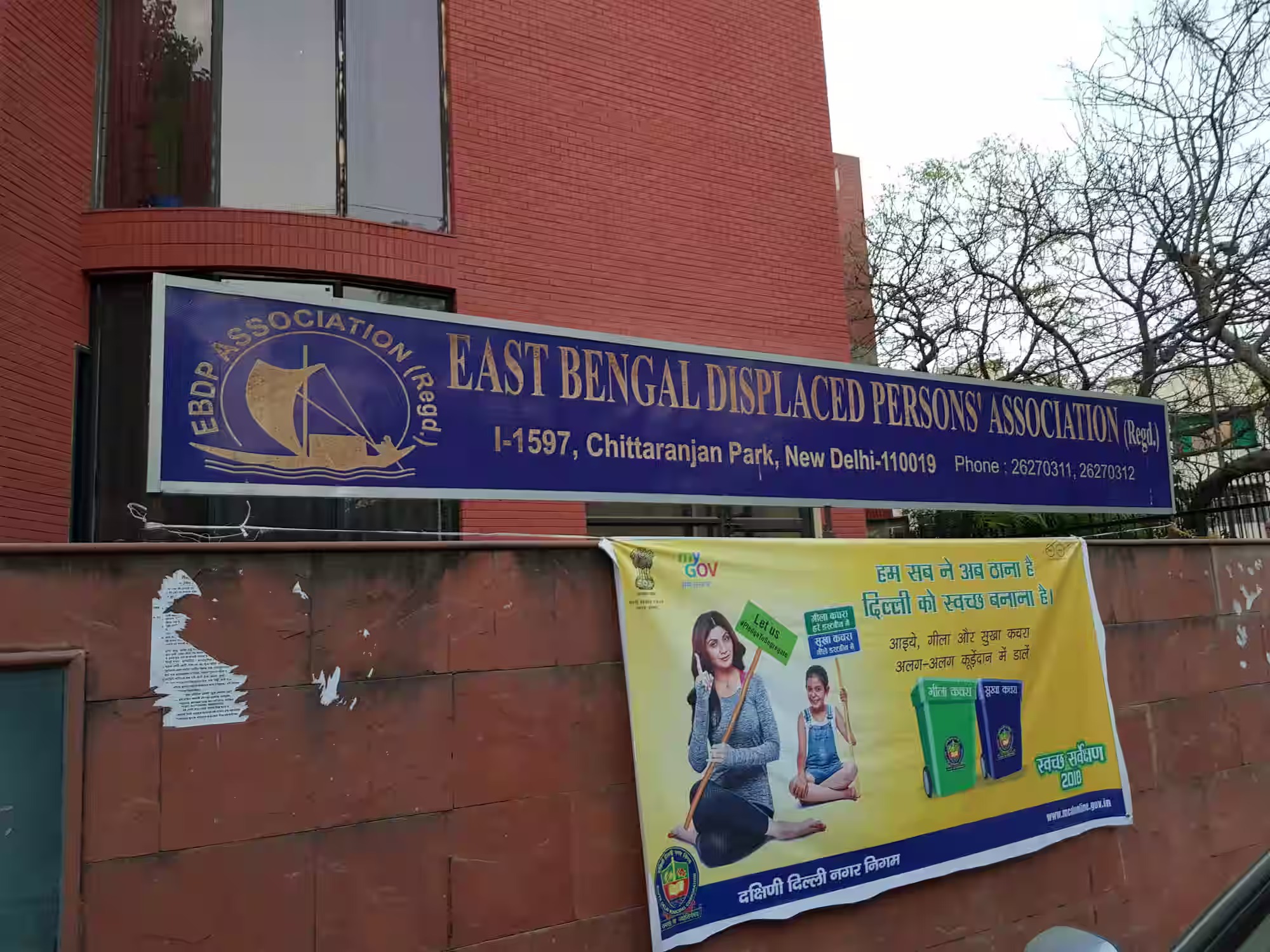
EPDP Office, Chittaranjan Park (Image source: Author)
For those who built it, C.R. Park was both a refuge and a re-creation of lost roots. The trauma of displacement intertwined with nostalgia for a homeland left behind. Healing, for these residents, was not clinical but communal; found in the laughter of neighbourhood addas, the rhythms of Durga Puja, and the shared recollections of survival and rebuilding.
As homes rose one by one, so did the rhythm of community life. Durga Puja, the grand festival of the Goddess, soon became the heartbeat of the new colony, a vibrant assertion of cultural identity amidst displacement. What began as a modest celebration in a few makeshift pandals grew into one of Delhi’s most iconic Pujas, transforming the barren land into a space of collective devotion and joy. For many, the sounds of the dhaak and the fragrance of shiuli blossoms marked not just the arrival of the Goddess, but a reaffirmation that homes could be rebuilt, and faith re-rooted.
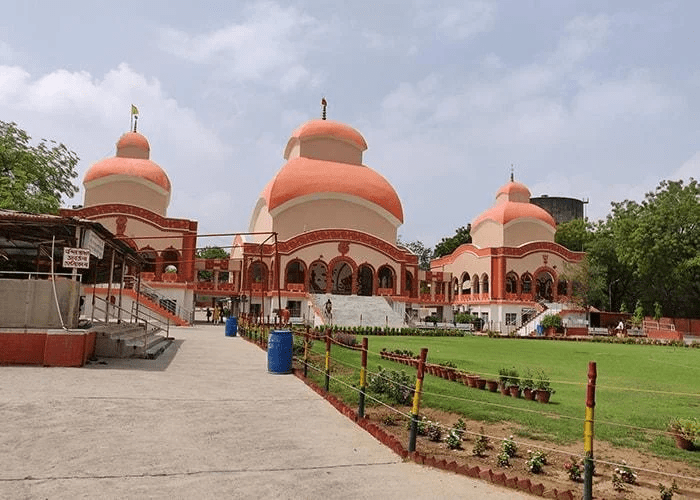 Kali Mandir, Chittaranjan Park (Image source: Author)
Kali Mandir, Chittaranjan Park (Image source: Author)The story of C.R. Park is, therefore, more than the story of a place. It is a chronicle of collective healing where displacement gave rise not to despair but to dialogue, not to silence but to song. In its courtyards and streets, in its festivals and addas, one finds the enduring truth that wellbeing is not just biological – it is cultural, historical, and profoundly human.
Durga Puja: The Cultural Heartbeat of Chittaranjan Park
Every September- October, as the skies above Delhi turn a softer shade of blue and the evenings become gentler, a unique rhythm awakens in the lanes of Chittaranjan Park.
Known for its bustling fish markets, food and Bengali culture, this otherwise quiet colony transforms into a dazzling theatre of lights, sound, colour, and devotion. The streets brim with people, the air resounds with the thunder of Dhaak/i> and the fragrance of Dhuno with the sweet scent of Shiuli blossoms. This is Durga Puja in Chittaranjan Park or Pujo, as Bengalis fondly call it, and for the thousands who gather here every year. It is not merely a festival, it is memory, emotion, identity, and above all, a longing for home.
To understand what Pujo means here, one must revisit the late 1960s, when C. R. Park was first carved out as the East Pakistan Displaced Persons Colony. Families who had crossed the border during Partition, and later during the Bangladesh Liberation War, carried with them their language, their food, their music, and their divinities. Most of all, they carried Durga.
In those early days, the first pujas were humble affairs; bamboo frames draped with cloth, simple clay idols, modest pandals. Yet when the Dhaaksounded, echoing across the dusty grounds, hearts leapt. “For a few days, we were back in Bengal,” an elderly resident once told me. “The goddess reminded us that we still had a mother who had not abandoned us.” In those words lies the emotional seed of why C. R. Park’s Durga Puja still matters today.
Durga Puja in the Bengali imagination is never just a religious ritual. It is the Agomoni, the arrival of the goddess herself. It marks the closing of the sombre Pitr Paksh the fortnight dedicated to honouring ancestors, and the beginning of the luminous , when the goddess descends to earth. But she does not come alone. She arrives with her children Ganesh, Kartik, Lakshmi, and Saraswati to her baaper baadi, her father’s house also called maayka. For four days she is no longer a distant deity enthroned in the heavens but a daughter returning home. She is welcomed with the affection of any child who comes back for a fleeting visit, only to leave again. This simple, humanised understanding of the goddess is what makes her so beloved in Bengali households. She is our Ma, a mother, a daughter, a guardian.
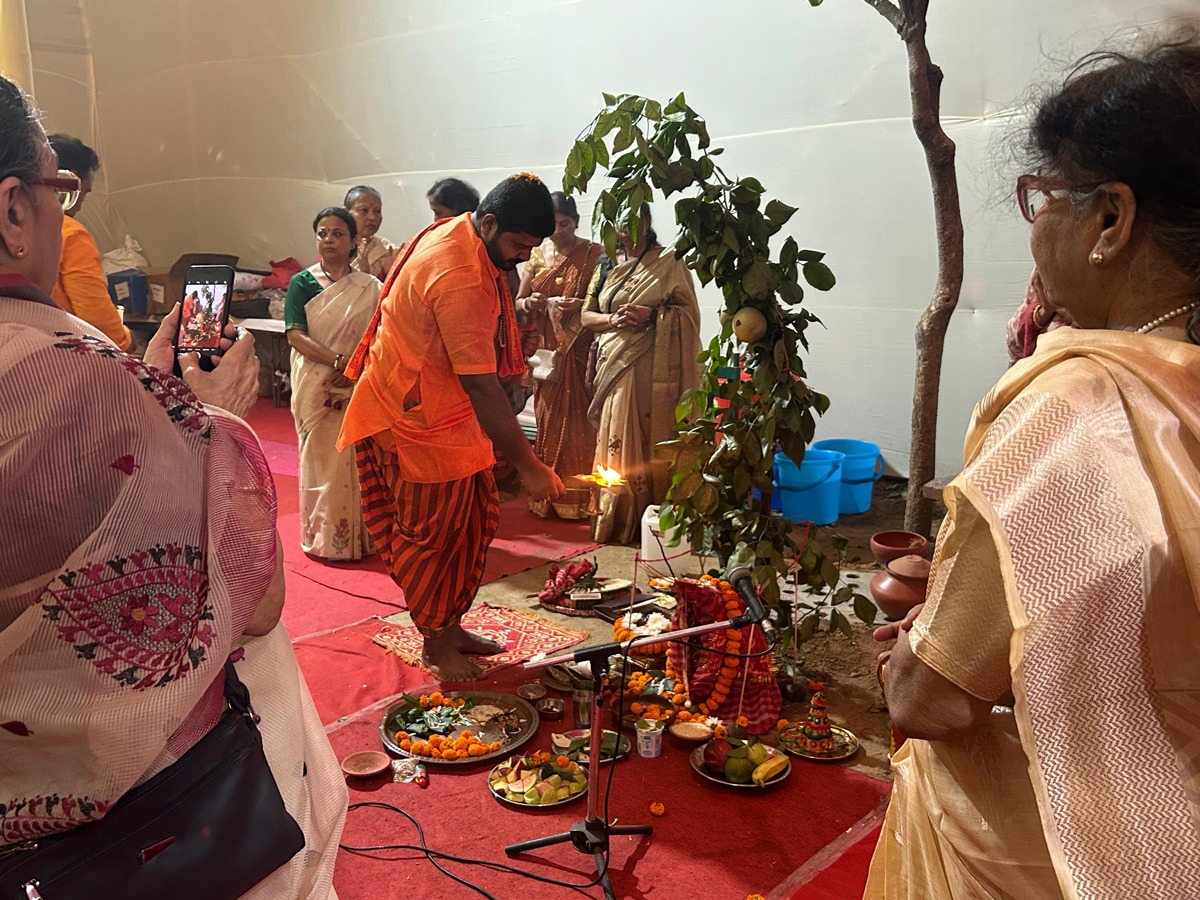 Agomoni Puja, E Block, Chittaranjan Park (Image source: Author)
Agomoni Puja, E Block, Chittaranjan Park (Image source: Author)The rituals themselves are woven with emotion. On Shashthi, when the goddess is unveiled, the excitement is palpable. Agomoni songs fill the air, announcing her arrival. On Saptami, the nabapatrika a symbolic form of the goddess tied in banana leaves is bathed at dawn. On Ashtami, the fragrance of dhunofills the pandals as women dance in devotion during dhunuchi naach, their bodies swaying with incense burners. And on Dashami, as the idols are prepared for immersion, women playfully smear vermilion on each other in the ritual ofsindoor khela. Yet beneath the playfulness lies poignancy; the recognition that the goddess must now leave, just as a married daughter leaves her parents’ home. The cry of “Aasche bochhor abar hobe” (she will come again next year) captures both the sorrow of parting and the promise of return.
In C. R. Park, this story resonates with a special intensity. For families once displaced from their ancestral homes, Durga’s return each year symbolises the permanence of belonging even in new soil. I remember standing in front of an idol on Shashthi evening. Beside me, my mother whispered softly, “Maa eshe geche” “Maa is here”. Her eyes glistened, and I could sense that for her, the goddess’s arrival was not just about faith but about continuity, about reclaiming roots that time and distance could never sever.
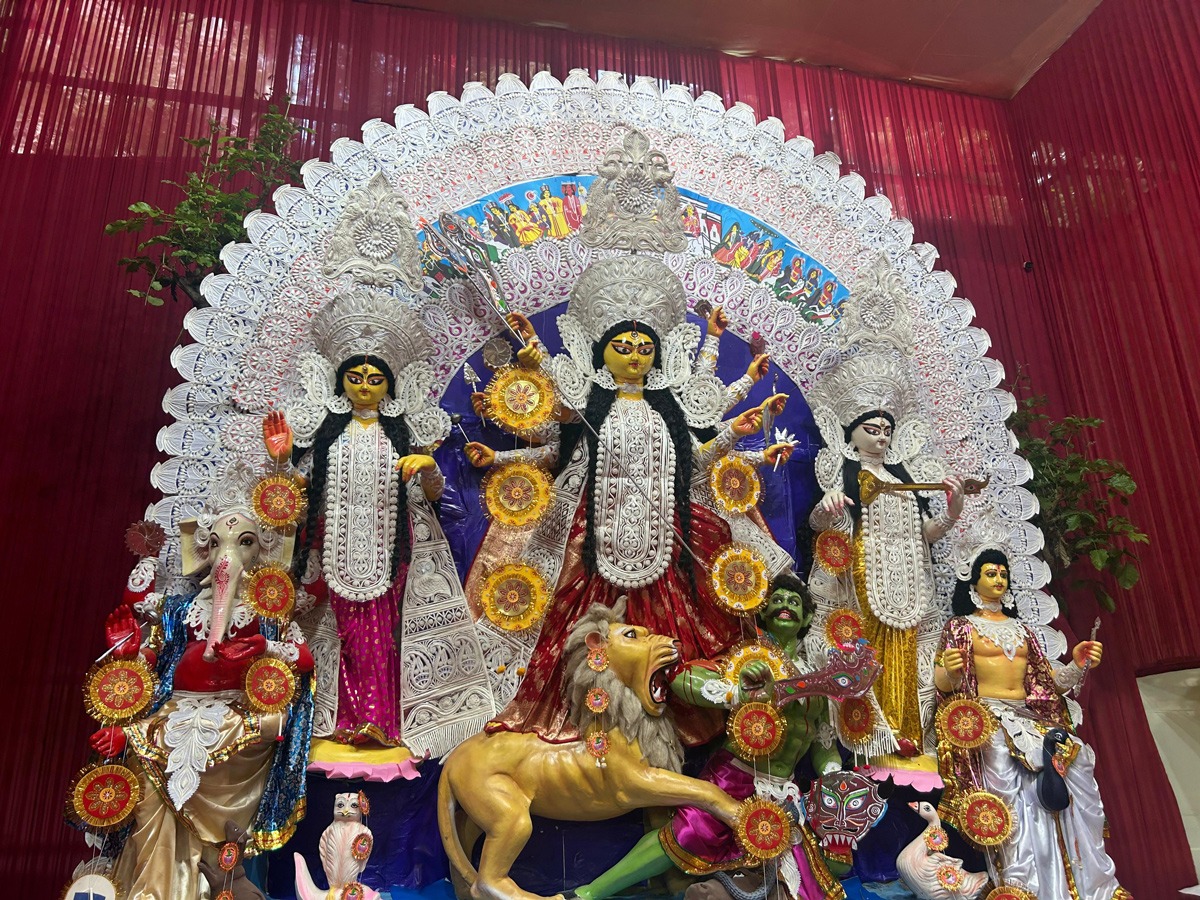 Durga idol unveiled E Block, Chittaranjan Park (Image source: Author)
Durga idol unveiled E Block, Chittaranjan Park (Image source: Author)Durga Puja Today…
Over the decades, the pujas here have grown into spectacular affairs. Each block competes to outdo the other with ever more elaborate pandals: one year a replica of Bishnupur’s terracotta temples, another year a recreation of Ajanta’s cave frescoes, sometimes even futuristic eco-friendly marvels built entirely of bamboo and cane.
Artisans pour their imagination and skill into these creations, transforming Delhi into a living museum of craft and devotion. The idols themselves range from traditional ekchala clay images to experimental designs. Walking through these pandals at night, lit by fairy lights and alive with chatter, feels like stepping into a dreamscape where the sacred and the creative blend seamlessly.
The true soul of the celebration lies in its simplicity in the bhog. On afternoons of Saptami, Ashtami and Navami, long queues snake outside the pandals as devotees wait patiently for the sacred meal. Khichuri, labra, chutney, papad, and payesh are served. The food is humble, but eaten in community, it feels divine. I recall one sweltering October afternoon when, exhausted from waiting in line, I was offered a steel tumbler of water by a complete stranger. We ended up sharing the bhogside by side. The food tasted like nectar, not because of its richness, but because it was shared. That is Pujo, strangers becoming family, the act of eating together dissolving all boundaries.
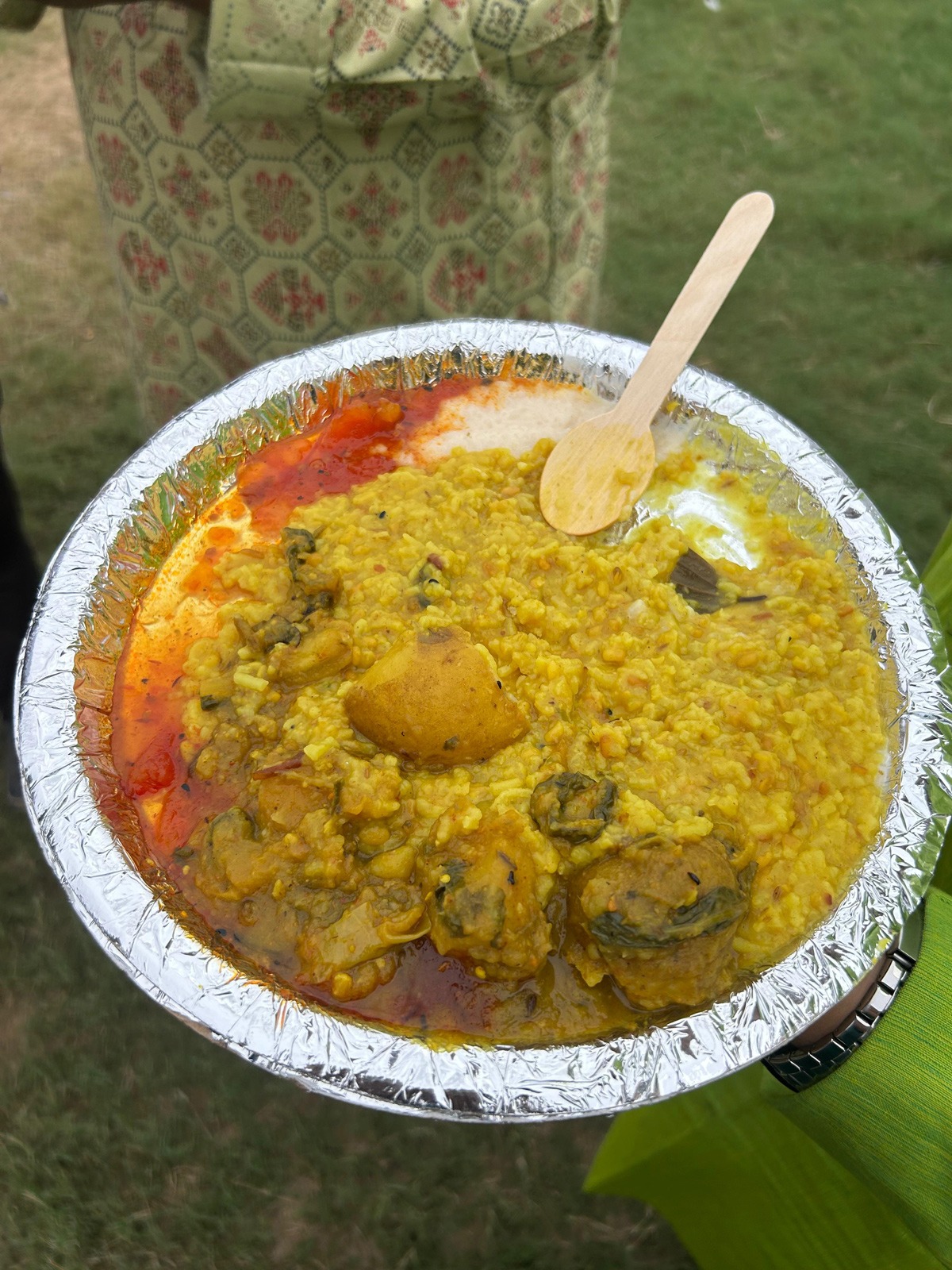 The Bhog including Khichadi, Labda, Chatni and Payash (Image source: Author)
The Bhog including Khichadi, Labda, Chatni and Payash (Image source: Author)Evenings bring another transformation. The pandals turn into cultural arenas and stages where music, dance, theatre, and poetry unfold. Children rehearse folk plays with infectious enthusiasm, teenagers sing Rabindra Sangeet, and seasoned performers from Kolkata enthral with their artistry. Sometimes the performances are flawless, sometimes delightfully imperfect – but always filled with the spirit of belonging.
This year, the Durga Puja at C.R. Park witnessed a moment of great pride when the Hon’ble Prime Minister Shri Narendra Modi visited the neighbourhood to offer his greetings and participate in the festivities. His presence at one of Delhi’s most iconic community-led Pujas was was an acknowledgment of the colony’s remarkable journey from displacement to cultural renaissance. As he walked through the decorated pandals and interacted with residents, there was a palpable sense of validation among the community, a recognition that their decades of perseverance, creativity, and cultural continuity had become a living symbol of India’s plural spirit. For many, the visit evoked memories of the earliest Pujas, once held in humble tents, now celebrated with grandeur yet grounded in nostalgia.
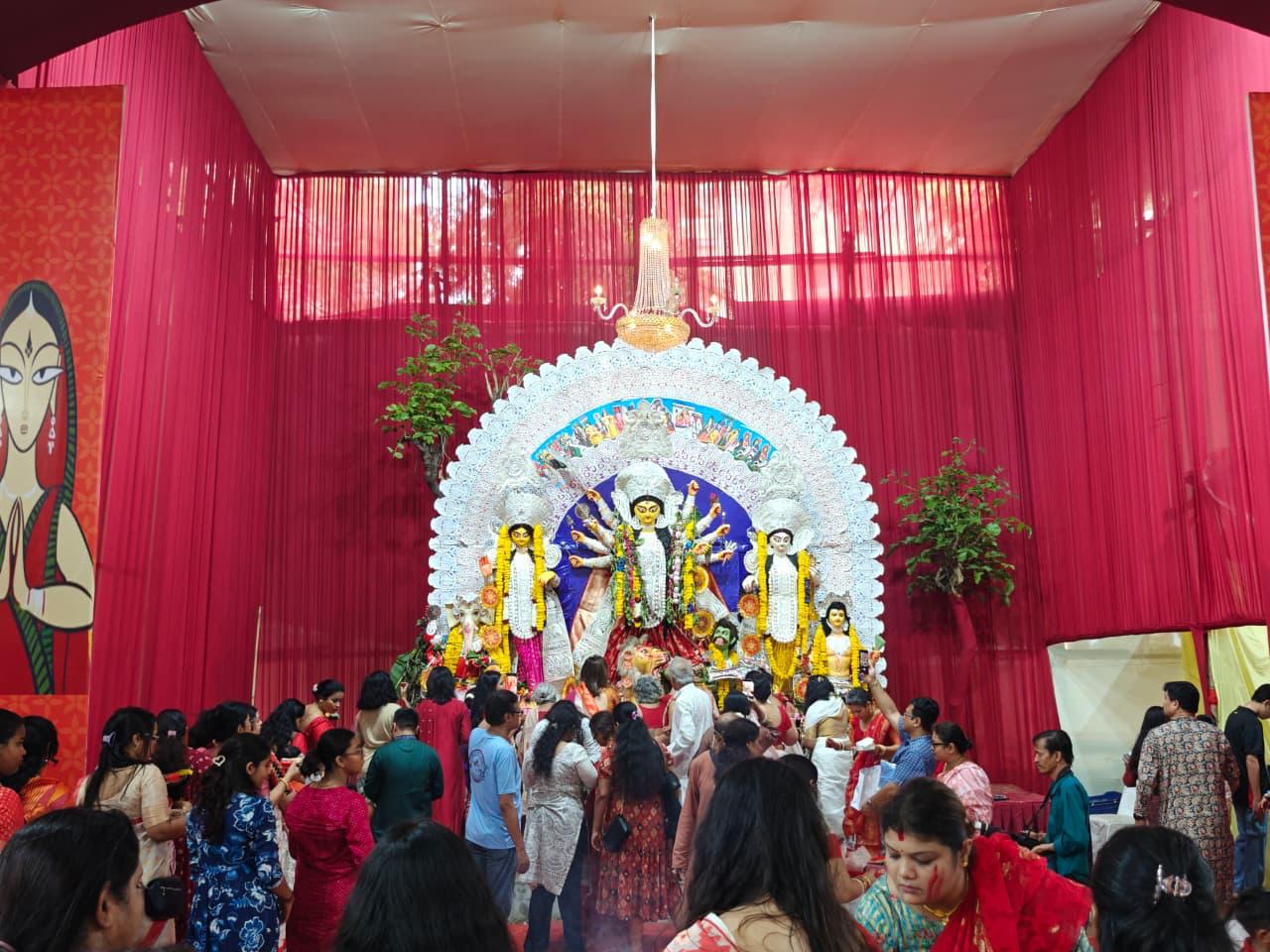 Durga idol on the day of Dashami, Chittaranjan Park (Image source: Author)
Durga idol on the day of Dashami, Chittaranjan Park (Image source: Author)Durga Puja’s relevance today lies in exactly that spirit. In an urban world where isolation and individualism often dominate, Pujo reminds us of community, continuity, and shared joy. For the older generation, it is nostalgia a link to the Bengal they left behind. For the younger, it is a way to anchor themselves in their roots while embracing Delhi’s cosmopolitan rhythm. And for countless others, Bengali or not, it is the story of a mother who comes home to her children, of a goddess who defeats darkness, and of a cycle that promises renewal each year.
The Goddess returns
As the conch shells echo one last time and the air fills with the bittersweet scent of sindoor and tears, Dashami arrives , the day when the Goddess returns to her celestial abode. Women smear each other with vermilion, their laughter trembling with emotion, while men stand silently, watching the idols carried away through the same lanes that had burst with celebration just days before.
In C.R. Park, too, the final immersion feels deeply personal as if the community is bidding farewell to a beloved family member. The rhythmic chants of “Asche bochor abar hobe” “She will return next year” remind everyone that this ending is not an end, but a promise of renewal. The river carries away the clay, but the spirit of Durga of strength, unity, and homecoming stays behind in every heart.
This article by Dr. Pratishtha Mukherjee. An archaeologist, educator, and researcher and PhD from The Maharaja Sayajirao University of Baroda. Currently an assistant professor at Rishihood University. Her publications span Buddhist art, Shaivism, and temple architecture. Passionate about heritage outreach, she continues to make archaeology accessible beyond academia.

